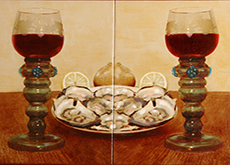Dutch Masters' Process Meets Technology
December 5, 2013
 “Fijnschilderij” is a Dutch term used to describe fine painting employing methods used by 17th century Dutch Masters to create as natural a reproduction of reality as possible in meticulously executed works. Through extreme attention to detail resulting in works with smooth surfaces completely lacking painterly brush strokes, the artists employ a glaze with a varnish base mixed with oil, to create a transparent color coating. Highlights were added and finished with an amber-colored varnish. The process made the paintings highly realistic in nature, creating an illusion of three-dimensional space. Westphal Arts Administration Alumna and Director of the Westphal Administrative Services, Rosalind Sutkowski, conducted research on the artists of the Dutch Golden Age for her Master’s thesis. The experience inspired her to create a series of simulated Fijnschilderij paintings, 22 of which will be included in a Drexel University exhibition opening next month.
“Fijnschilderij” is a Dutch term used to describe fine painting employing methods used by 17th century Dutch Masters to create as natural a reproduction of reality as possible in meticulously executed works. Through extreme attention to detail resulting in works with smooth surfaces completely lacking painterly brush strokes, the artists employ a glaze with a varnish base mixed with oil, to create a transparent color coating. Highlights were added and finished with an amber-colored varnish. The process made the paintings highly realistic in nature, creating an illusion of three-dimensional space. Westphal Arts Administration Alumna and Director of the Westphal Administrative Services, Rosalind Sutkowski, conducted research on the artists of the Dutch Golden Age for her Master’s thesis. The experience inspired her to create a series of simulated Fijnschilderij paintings, 22 of which will be included in a Drexel University exhibition opening next month.
Sutkowski’s images of cottages, dual images of red stemware, seascapes and fields of grazing cows capture the Fijnschilderij of the Dutch Masters. She developed a new process for her exhibit pieces that combined the Old Masters’ methods with new technology. She begins with images from a digital camera, transposes the imagery in the computer and then prints them monochromatically on canvas. She glazes the picture with a color of transparent oil, adds highlights and finishes the painting with an amber-colored varnish. The glazing medium and the varnish are developed from sixteenth century Dutch practices.
“Simulated Fijnschilderij: Where Old Masters and Technology Meet” is a free and open-to-the-public exhibition that will open at Drexel’s Main Building’s third-floor Rincliffe Gallery (32nd and Chestnut Streets) on Jan. 10, running through March 14. It will be open on weekdays from 8:00 a.m. to 8:30 p.m. and on weekends from 9:00 a.m. to 5:00 p.m.